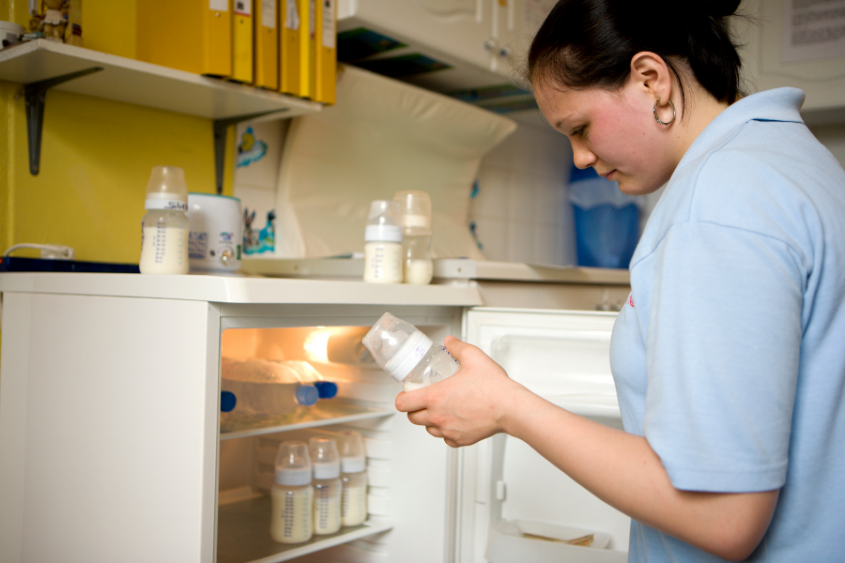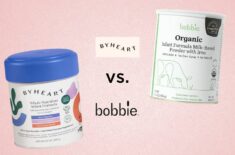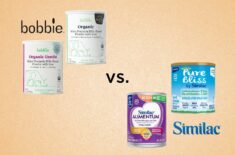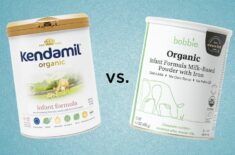Baby Formula: A Guide To Choosing The Best For Your Little One
Overview
While there’s no absolute right or wrong formula, choosing the right one for your baby could make a huge difference, especially if your child has hypersensitivity to a certain ingredient.
Each child and each formula is different. Remember, what works for other babies might not be suitable for your child.
But there are still some things for you to consider in choosing the best formula for your little one. Your child’s safety should always be the top priority, no matter which brand or infant formula you choose.
Here’s a guide that may help you choose the best baby formula:
- Always consult with your pediatrician before you start with or switch to a new formula.
- Make sure to check whether your child might have allergies to certain components in the formula.
- If your child has food intolerances, allergies, or sensitivities, always check the label of any formula you’re planning to buy.
- Don’t forget to monitor your child for any allergic reaction to a new formula. Some symptoms of allergies include hives, sneezing, wheezing, stomach upset, and watery, itchy, or swollen eyes. (1)
- Stay updated with the latest news or information about baby food and formula recalls. Never give any recalled formula to your child, especially those recalled due to contamination. Even if it looks alright, deadly pathogens might be lurking inside them.
Also check whether your formula prep machine is producing the right temperature (≥70°C or ≥158°F) to eliminate bacteria or other pathogens, and reduce infection risks.
Is Formula As Good As Breastmilk?
If possible, pick a formula that closely replicates breast milk.
Molecular biotechnologist and biochemist Rebecca Fett, author of Brain Health from Birth, suggests for you to look for these top ingredients: (2)
- Whey proteins or partially hydrolyzed whey
- Lactose as the primary carbohydrate.
- Prebiotics that can support a healthy gut microbiome
- MFGM (Milk Fat Globule Membrane), which can play a role in your baby’s cognitive development. (3)
Fett further suggests that you should choose a formula based on what your child needs. This may be more important than picking an organic formula because tests have consistently shown that finished infant formulas don’t contain pesticides. (4)(5)
If your baby has reflux, colic, or allergies, choosing a partially hydrolyzed, 100% whey-based formula can be your priority. (2)
What other factors should you consider? Is formula ever better than breast milk? Learn more about baby formulas below.
Which Formula Milk Is Best For Babies?
Most formulas can provide your baby with complete nutrition for proper growth and development.
But the right formula should provide your baby with all these nutrients while also ensuring that it’s safe for your child to take.
Top Ingredients to Consider
Because your milk is your baby’s best source of nutrition, the AAP (American Academy of Pediatrics) recommends exclusive breastfeeding throughout the first six months of life. (6)(7)
Still, some moms might need or choose formula feeding for various reasons. If you choose to give formula, it might be ideal to find one that closely matches breast milk.
But remember that no formula is the best choice for all babies. So, you should try to weigh your priorities and your baby’s needs to find the best one.
What Is The Closest Formula To Breast Milk?
If your baby doesn’t have allergies, any contraindications, or special dietary requirements, you can choose formulas with the following ingredients because they closely resemble breast milk: (2)
- Whey proteins or partially hydrolyzed whey
- Lactose (primary carbohydrate)
- Prebiotics
- MFGM
Whey Proteins In Formula
There are two main protein types in human breast milk and cow’s milk: (7)
- Casein
- Whey
Casein solidifies to curds in your baby’s stomach while whey remains liquid. That’s why whey can be easier to digest. (7)
But did you know that the composition of breast milk changes over time to meet the needs of your baby? The level of nutrients can change, but numerous studies have shown that these dynamic changes adapt to your child’s needs. (7)
In human breast milk, the percentage of whey starts at 70% to 80% during early lactation, then decreases to around 50% in late lactation. (7)
Many traditional infant formulas contain cow’s milk. However, cow’s milk only contains around 18% whey. Because of their high casein content, regular formulas may be more difficult to digest than breast milk or formulas based on whey proteins. (7)
So, if possible, choose a formula that’s made from whey. This key ingredient may be listed as whey proteins or partially hydrolyzed whey. (2)(7)
Examples of formulas with whey proteins:
- Enfamil NeuroPro Gentlease
- Similac Pro-Total Comfort
- Enfamil Reguline
Lactose In Formula
Lactose in human breast milk provides around 40% of its total energy, while fats provide 50%. The foremilk (the milk first drawn during feeding) contains more lactose than the hindmilk (the main milk drawn during feeding, with richer nutrient content). (7)
Because it’s a sugar naturally found in breast milk, choosing a formula with lactose as the main carbohydrate makes sense.
This sugar plays several important roles: (7)
- It may help promote better milk flow.
- It may aid in the proper absorption of calcium and other minerals
- Many carbohydrate-based bioactive compounds in breast milk, such as oligosaccharides, are attached to lactose.
Examples of formulas with lactose as the main carbohydrate:
- Enfamil Enspire
- Similac Pro-Advance
- Earth’s Best Organic Dairy Infant Powder
Prebiotics & Probiotics In Formula
HMOs (human milk oligosaccharides) are unique to humans. Breast milk contains different types of HMOs which act as prebiotics. (7)
Prebiotics are fibers that the human body can’t digest but can be food for probiotics, the helpful bacteria in your baby’s tummy. (7)
Dairy milk contains other types of prebiotics. But many formulas now come with prebiotics identical to the HMOs. The 2’-FL HMO (2’-fucosyllactose human milk oligosaccharide) is a commonly used prebiotic in formulas. (7)
L. reuteri DSM 17938 (Lactobacillus reuteri) and Lactobacillus rhamnosus GG cultures are two common probiotics added to formulas. (7)
Examples of formulas with prebiotics and probiotics:
- HiPP Dutch Organic Combiotic Infant Milk Formula – galacto-oligosaccharides (prebiotics) and Lactobacillus Fermentum cultures (probiotics)
- Similac Pro-Advance – 2’-FL HMO (prebiotics)
- Gerber Good Start Soothe – L. reuteri DSM 17938 (probiotics) and 2’-FL HMO (prebiotics)
- Gerber Good Start Gentle – B. lactis (probiotics) and 2’-FL HMO (prebiotics)
MFGM & Fats In Formula
While most of the focus is on proteins and lactose in formulas, fats may be the most important components of breast milk. Fats provide 50% of the milk’s energy and can help develop your baby’s central nervous system. (7)
Fats are also the carriers of taste and aroma. (7)
The MFGM (Milk Fat Globule Membrane) of breast milk contains plenty of bioactive components that may be important for your baby’s neurodevelopment and defense against infections. (8)(9)
Regular formulas traditionally lack MFGMs, but recent formulations may already include this important component. (8)(9)
Studies have shown that the addition of MFGMs in formulas may help improve your baby’s cognitive function and age-appropriate growth. It might also significantly decrease the incidents of diarrhea and respiratory-associated adverse events. (8)(9)
Examples of formulas with MFGM:
- Enfamil NeuroPro Gentlease
- Enfamil Enspire
- Kendamil Stage 2 Organic Baby Formula
Other Ingredients To Check Or Consider
Added Sugars, Corn Syrup, And Maltodextrin
If possible, try to avoid formulas with sucrose or added sugars, corn syrup, and maltodextrin. These are often used as sweeteners in lactose-free formulas. (4)
But you can still pick formulas with these ingredients, provided that they meet your baby’s other nutritional requirements. Maltodextrin and corn syrup are easily digestible forms of glucose and can still be safe for your baby, especially if you have limited choices. (4)
Just make sure you consult with your pediatrician before switching to a new formula.
DHA & ARA
Breast milk has omega-3 DHA (docosahexaenoic acid) and omega-6 ARA (arachidonic acid) fatty acids. Both play important roles in early development, particularly in cognitive and immune functions. (10)
Studies have shown that these fatty acids can help improve visual acuity (the eye’s ability to distinguish details), cognition functions, and immune system. (10)
Yet, there’s also concern about how these fatty acids, particularly DHA, are extracted from algal sources using a toxic chemical called hexane. (4)
But even if it’s processed in this manner, the hexane solvent is removed long before the DHA is added into the formula. So, the DHA in your baby’s formula is already hexane-free. (4)(11)
Still, Rebecca Fett suggests that you shouldn’t consider DHA and ARA as the main reason for picking your baby’s formula. (4)
But if you want a formula with DHA and ARA, you might choose this formula because its fatty acids are sourced from organic eggs, not algae (where hexane extraction is used):
- Baby’s Only Organic Sensitive DHA/ARA Formula
Palm Olein Oil
Palm olein oil is a common ingredient in many formulas, but it can affect calcium absorption and cause lower bone mass. (12)
Common Allergies Or Intolerances To Formula Components
Cow’s Milk Protein Allergies
Proteins are made up of amino acids. Whey and casein are made up of different amino acids. But both proteins can trigger an immune response. They can make milk a potential allergen. (7)
Cow’s milk protein allergy is fairly common. But while there’s currently no suitable treatment for this kind of allergy, you can prevent it through avoidance. (13)
Watch out for the following symptoms of cow’s milk protein allergy, which may appear one to two hours following your baby’s first dairy formula: (1)(7)
- Itchy, watery, or swollen eyes
- Hives
- Swelling
- Wheezing
- Trouble breathing
- Coughing
- Hoarseness
- Throat tightness
- Stomach upset
- Vomiting
- Diarrhea
In severe cases, it may lead to a drop in blood pressure, lightheadedness, or loss of consciousness. (1)
Consult with your baby’s pediatrician if you believe your child has milk allergies or intolerance. Skin tests might be performed to diagnose allergies so you can avoid formula with an ingredient that your child might be allergic to.
If you’re breastfeeding, you might also need to change your diet. Consult your doctor or an allergist. (1)
In choosing a formula for your baby with cow’s milk protein allergies, pick a non-dairy option. Because goat’s milk has similar proteins to cow’s milk, it might be best to avoid this kind of formula, too.
You should also note that a “partially hydrolyzed” formula isn’t fully hypoallergenic. It might still cause an allergic reaction in your baby. They’re ideal for use if your baby has mild spit-up, gas, colic, or fussiness due to lactose intolerance. (1)
Your baby might need a fully hydrolyzed formula or even an amino acid-based formula, depending on their level of sensitivity to cow’s milk proteins. Your baby’s pediatrician can help choose the right formula, especially if your baby has multiple food sensitivities or allergies. (1)
- Fully hydrolyzed formulas have their proteins fully broken down into small pieces that may no longer trigger an allergic reaction.
- Amino acid-based formulas are those whose proteins are further broken down into their amino acid building blocks.
Lactose Intolerance Or Malabsorption
Lactose is a sugar in milk, dairy products, and formulas coming from dairy sources. Plant-based formulas don’t contain lactose.
If your baby’s tummy doesn’t produce enough lactase, an enzyme that breaks down lactose, they might have lactose intolerance or malabsorption. (7)
While lactose intolerance isn’t life-threatening, it can cause a lot of discomfort to your baby. Symptoms can include: (14)
- Nausea
- Abdominal pain
- Cramping
- Bloating
- Loose stools and gas
- Watery diarrhea with gas
Watch out for these ingredients if your child has lactose intolerance: (14)
- Milk
- Lactose
- Whey
- Curds
- Milk by-products
- Dry milk solids
- Nonfat dry milk powder
To check for lactose intolerance, you can take out all milk products from your child’s diet for around two weeks. Monitor whether the symptoms will improve if they don’t eat foods with lactose. (14)
Your pediatrician might also perform a hydrogen breath test. (14)
There are different ways to deal with lactose intolerance. One is to avoid foods or formulas with lactose content. (14)
Another is for your child to receive lactase enzyme supplements. But don’t give these over-the-counter supplements to your child unless prescribed by your pediatrician. (14)
Soy formulas are among the most popular options for lactose-intolerant babies. (14)
Other options include milk from the following: (14)
- Almond
- Hemp
- Rice
- Oats
- Peas
Almonds may be a good source of calcium, but they contain fewer calories and proteins than cow’s milk. Also, almond milk isn’t ideal if your baby has tree nut allergies. (14)
Soy Allergies
Studies have shown that around 8-14% of babies with cow’s milk protein allergies also react to soy. (15)
These symptoms might appear within two hours of feeding: (15)
- Rash
- Hives
- Vomiting
A severe allergic reaction, called anaphylaxis, may lead to: (15)
- Wheezing
- Fast heartbeat
- Clammy skin
- Confusion and anxiety
- Collapsing or losing consciousness
Galactosemia
Lactose is broken down into simpler sugars called glucose and galactose. But some babies might have difficulty digesting galactose; it’s a condition called galactosemia. (16)
These symptoms might indicate that your child has galactosemia: (16)
- Spit up
- vomiting
- Refusal to eat
- Jaundice or yellowing of the skin
- Lethargy
- Cataracts
If left untreated, galactosemia can lead to various learning and developmental delays or serious medical conditions, including: (16)
- Speech delays
- Speech difficulties
- Problems with reading and math
- Problems with fine and gross motor skills
- Fine motor tremors
- Problems with balance or gait
- Ataxia or inability to coordinate voluntary movements
- Tremors or involuntary muscle contractions
- Dysmetria or inaccurate distance estimation
- Ovarian failure in female patients
Currently, the only treatment for galactosemia is avoidance of any food with lactose or galactose. So, you should pick a dairy-free formula if your baby has this condition. (16)
But make sure to consult with your baby’s pediatrician before picking any formula.
Classes Of Formulas
Manufacturers have created different types of formulas to meet the different needs of every child.
The following are some of the main classes of formulas that can provide complete nutrition for your child.
Traditional & Regular Formulas With Special Ingredients
Traditional formulas are sourced from cow’s milk. These regular formulas contain lactose as the main carbohydrate and have added vegetable oils, minerals, vitamins, and iron.
They can be available as powder infant formulas or ready-to-drink ones.
As basic formulas, they can also have the lowest prices.
There are also regular formulas with special ingredients.
These upgraded formulas may contain special ingredients such as MFGM (Milk Fat Globule Membrane) which may play a role in your baby’s cognitive development. (3)
Other formulas contain probiotics, prebiotics, DHA, ARA, and other special ingredients.
Some examples of these traditional formulas include the following:
- Similac Advance
- Enfamil Enspire
Non-Dairy, Soy Formulas
If your child needs a dairy-free formula because of cow’s milk protein allergies or other reasons, soy formulas might be an option.
Some examples are the following:
- Similac Soy Isomil
- Enfamil ProSobee
- Gerber Good Start Soy
Soy-Free Formulas
If your child has soy allergies, you can try these formulas:
- Else Plant-Based Complete Nutrition for Toddlers
- Baby’s Only Organic Pea Protein Formula
Lactose-Free Formulas
If your child has lactose intolerance, then you can pick a dairy-free formula. But it’s still possible to give your baby formula from cow’s milk; however, it should be lactose-free.
Some examples of lactose-free formulas include:
- Similac Alimentum
- Enfamil Nutramigen
- Similac Pro-Sensitive
- Nestlé Alfamino Infant Formula
- Gerber Good Start Soy Powder Infant Formula
GMO Vs. Non-GMO Formulas
Many parents are concerned over GMOs (genetically modified organisms) in infant formula and solid foods.
Some pediatricians recommend choosing non-GMO infant formula. It may help avoid the risks of your child developing possible GMO-triggered autoimmunity, allergies, and certain conditions. (17)
But the FDA assures the public that GMOs are regulated, and only safe products are released. (18)
While it remains a subject of debate, you can opt for GMO-free formulas for your peace of mind. Some examples are the following:
- Holle Goat Based Formula
- HiPP Dutch Organic Combiotic Infant Milk Formula
- Similac Pro-Advance
- Enfamil Neuropro Gentlease
Organic Infant Formulas
Note that non-GMO formulas may still come from non-organic sources, but all organic formulas are free from GMOs.
Rebecca Fett acknowledges that organic infant formula may be a healthier alternative. Yet, she also recommends that your main goal should be to provide your child with a formula as close in composition to breast milk as possible. (4)
She says: (2)
“The scientific evidence indicates that it is more important to choose a formula with the key ingredient shown to support brain and immune health, rather than choosing organic.”
While there’s also nothing wrong with choosing organic to provide your baby with a safe formula that’s free from any pesticide, insecticide, or herbicide residues, your child might be missing out on some important nutrients found in regular formulas. (4)
For example, many organic formulas don’t have added ingredients such as MFGM (Milk Fat Globule Membrane), which can benefit your baby’s cognitive development. (3)(4)
Also, it might be difficult to find an organic formula with prebiotics and based on whey. (4)
Still, if you want to choose an organic formula, here are some options:
- Earth’s Best Soy-Based Infant Formula
- Else Plant-Based Complete Nutrition for Toddlers
- Happy Baby Organic Formula
Sensitive & Specialized Formulas
Partially Hydrolyzed Formulas
If your baby has reflux, colic, or allergies, choosing a partially hydrolyzed, 100 percent whey-based formula can be your priority. (2)
The proteins in this formula are easy to digest because they’re much smaller than the ones in regular formula.
Examples of these formulas are the following:
- Enfamil NeuroPro Gentlease
- Gerber Good Start Gentle
- Similac Pro-Total Comfort
Partially hydrolyzed formulas originally come from cow’s milk proteins (whey and casein), but the proteins are broken down into smaller pieces. (15)
Some formulas contain a blend of partially hydrolyzed whey and casein. Others can have 100% hydrolyzed whey proteins. Note that you shouldn’t give these formulas to infants allergic to cow’s milk. (15)
Extensively Hydrolyzed Formulas
Cow’s milk protein called casein is a common cause of allergy symptoms. This protein is broken into tinier pieces in extensively hydrolyzed formulas. Around 90% of babies with cow’s milk allergies can tolerate these formulas. (15)
These extensively hydrolyzed formulas can provide complete nutrition if your baby is allergic to cow’s milk protein. (15)
Some examples are the following:
- Enfamil Nutramigen
- Enfamil Pregestimil
- Similac Alimentum
- Similac Expert Care
Amino Acid-Based Formulas
If your child can’t tolerate extensively hydrolyzed formulas, your pediatrician might prescribe an amino acid-based formula. (15)
These specialized formulas are made of proteins that are further broken down into their building blocks called amino acids. Because they don’t contain any intact proteins, they are more tolerated by children with protein allergies. (15)
Because of their composition, amino acid-based formulas are also called “elemental” formulas.
Examples are the following:
- Neocate
- Similac EleCare
- Enfamil PurAmino
- Nestle Alfamino
Baby Formula FAQs
Is Formula Bad For Babies?
Though experts recommend breastfeeding as the best nutritional source for babies, infant formula is also available for those who want or need to provide another option. (19)
Commercially prepared liquid and powdered formulas are manufactured under sterile conditions, designed to duplicate human breast milk as much as possible, and are tested for safety and nutritional values. (7)(19)
Formula feeding can also provide you with a convenient and flexible option.
Studies have shown that formula may provide proper nutrition for your baby. (5)(7)
Is Formula Ever Better Than Breastfeeding?
Breast milk can provide your baby with almost all the vitamins and minerals needed for growth, except vitamins D and K. (7)
- Vitamin D is essential for promoting the growth and development of your child’s bones, brain, and immune system. (7)
- Vitamin K is also essential for regulating blood calcium levels, promoting bone metabolism, and playing a role in blood clotting. (7)
This is where formulas can be better than breastmilk because these commercially available products are fortified with these vitamins. Exclusively breastfed infants may need supplementation for vitamins D and K unless you choose to take the supplements. (7)
To provide your baby with enough of the vitamin in your breast milk, you might need to take at least 2,000 IU of vitamin D. (7)
Can I Make My Own Formula?
Never make your own formula at home. The FDA approves commercial formulas. They’re created through highly specialized processes and have gone through multiple tests before being released for public consumption. (1)
A homemade formula might not provide your baby with enough nutrients needed for proper growth and development. Worse, it might cause an illness. (1)
Can I Give Pure Cow’s Milk?
Never give your child pure cow’s milk. It contains high protein, sodium, and potassium levels that your baby’s systems can’t handle. (7)
REFERENCES
(1) https://kidshealth.org/en/parents/milk-allergy.html
(2) https://brainhealthfrombirth.com/formula/
(3) https://bmcpediatr.biomedcentral.com/articles/10.1186/s12887-020-02087-9
(4) Fett, R. 2019. Brain Health from Birth: Nurturing Brain Development During Pregnancy and the First Year. Franklin Fox Publishing LLC.
(5) https://www.ncbi.nlm.nih.gov/books/NBK236264/
(6) https://publications.aap.org/pediatrics/article/129/3/e827/31785/Breastfeeding-and-the-Use-of-Human-Milk
(7) https://www.ncbi.nlm.nih.gov/pmc/articles/PMC4882692/
(8) https://pubmed.ncbi.nlm.nih.gov/30865975/
(9) https://pubmed.ncbi.nlm.nih.gov/27234413/
(10) https://pubmed.ncbi.nlm.nih.gov/29413359/
(11) https://www.ams.usda.gov/sites/default/files/media/DHA%20Algal%20Oil%20TR.pdf
(12) https://pubmed.ncbi.nlm.nih.gov/16582027/
(13) https://pubmed.ncbi.nlm.nih.gov/23954566/
(14) https://www.healthychildren.org/English/healthy-living/nutrition/Pages/Lactose-Intolerance-in-Children.aspx
(15) https://www.kidswithfoodallergies.org/formula-options-for-infants-with-food-allergies.aspx
(16) https://www.childrenshospital.org/conditions-and-treatments/conditions/g/galactosemia/symptoms-and-causes
(17) https://www.greenamerica.org/blog/downsides-gmo-infant-formula-we-asked-pediatrician
(18) https://www.fda.gov/food/agricultural-biotechnology/how-gmos-are-regulated-food-and-plant-safety-united-states
(19) https://kidshealth.org/en/parents/breast-bottle-feeding.html












